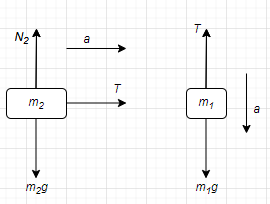College Physics
11th Edition
ISBN:9781305952300
Author:Raymond A. Serway, Chris Vuille
Publisher:Raymond A. Serway, Chris Vuille
Chapter1: Units, Trigonometry. And Vectors
Section: Chapter Questions
Problem 1CQ: Estimate the order of magnitude of the length, in meters, of each of the following; (a) a mouse, (b)...
Related questions
Question
Calculate these equations; (Eq. 1), (Eq. 2), and (Eq. 3).
m1 (hanging mass) = 3kg
m2 (cart) = 1 kg

Transcribed Image Text:M.
start
Left Rope Tension: 9.8 N
Right Rope Tension: 9.8 N
Time: 0.74 s
Displacement: 2.02 m

Transcribed Image Text:The weight of the hanging mass (the gravitational force pulling downward on the hanging mass)
is the accelerating force for the system:
Eq. 1
F = Whanging = m1g
Since this unbalanced force is also described by Newton's Second Law, you can find the
expected acceleration of the system, where M is the total mass of the system (cart plus hanging
mass):
Maexpected
Solving these together, the acceleration can be shown to be:
Σ
m19
Eq. 2
dexpected
M
M
You will be recording the displacement of the hanging mass (and therefore the cart as well
since they are attached to each other) and the time for each trial. The displacement and time
values can be used to calculate the experimental acceleration by solving this kinematic
equation for a:
Eq. 3
Ay =
at?
Expert Solution
Step 1
Consider the free-body diagram of the cart and the hanging mass as follows.

Step by step
Solved in 4 steps with 1 images

Knowledge Booster
Learn more about
Need a deep-dive on the concept behind this application? Look no further. Learn more about this topic, physics and related others by exploring similar questions and additional content below.Recommended textbooks for you

College Physics
Physics
ISBN:
9781305952300
Author:
Raymond A. Serway, Chris Vuille
Publisher:
Cengage Learning

University Physics (14th Edition)
Physics
ISBN:
9780133969290
Author:
Hugh D. Young, Roger A. Freedman
Publisher:
PEARSON

Introduction To Quantum Mechanics
Physics
ISBN:
9781107189638
Author:
Griffiths, David J., Schroeter, Darrell F.
Publisher:
Cambridge University Press

College Physics
Physics
ISBN:
9781305952300
Author:
Raymond A. Serway, Chris Vuille
Publisher:
Cengage Learning

University Physics (14th Edition)
Physics
ISBN:
9780133969290
Author:
Hugh D. Young, Roger A. Freedman
Publisher:
PEARSON

Introduction To Quantum Mechanics
Physics
ISBN:
9781107189638
Author:
Griffiths, David J., Schroeter, Darrell F.
Publisher:
Cambridge University Press

Physics for Scientists and Engineers
Physics
ISBN:
9781337553278
Author:
Raymond A. Serway, John W. Jewett
Publisher:
Cengage Learning

Lecture- Tutorials for Introductory Astronomy
Physics
ISBN:
9780321820464
Author:
Edward E. Prather, Tim P. Slater, Jeff P. Adams, Gina Brissenden
Publisher:
Addison-Wesley

College Physics: A Strategic Approach (4th Editio…
Physics
ISBN:
9780134609034
Author:
Randall D. Knight (Professor Emeritus), Brian Jones, Stuart Field
Publisher:
PEARSON